By Patrick Colbeck
In the wake of the passage of the Help America Vote Act in 2002, states were incentivized to centralize the management of their voter rolls in a state voter registration database. Prior to that, local clerks were predominantly responsible for the integrity of the voter rolls within their respective jurisdiction. Voter roll management was largely a decentralized operation. HAVA centralized the management of voter rolls making them much more vulnerable to systemic corruption. The ability to corrupt the voter rolls opens the door to the insertion of fake voters or fraudulently casting ballots on behalf of real people who did not vote.
Fake voters or fake votes by real people are the key enablers of mail-in ballot fraud. Mail-in voting is a third party transaction. That means that the actual voter is not physically present to cast their vote. Rather than personal identification such as a photo ID, poll workers and local election officials rely upon the integrity of the information in statewide voter registration databases when they process absentee ballots. When this information is compromised, even the most honest poll workers and local election officials are capable of presiding over a fraudulent election.
The Problem
According to an internal memo from former Michigan Secretary of State Ruth Johnson to her colleagues in the Michigan Senate, there were over 800,000 ineligible voters in the Michigan Qualified Voter File during the 2020 General Election.

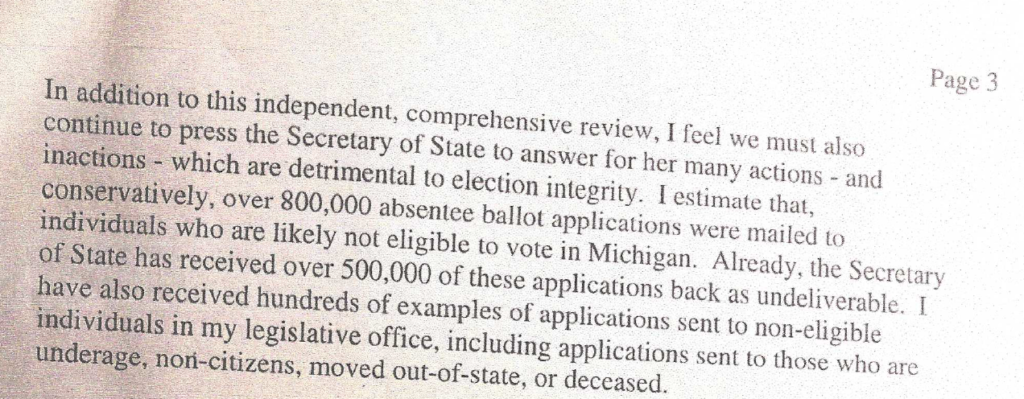
According to the official records maintained by the Michigan Secretary of State, 5,579,317 ballots were cast during the 2020 general election of which 5,539,302 votes were cast for President. The official election results state that the margin of victory in the Presidential race in Michigan was 154,188 votes in favor of Joe Biden. Based upon official records provided by the Michigan Secretary of State as of 9/1/22, the Election Integrity Force determined that over 170,000 ballots were cast in the 2020 election that had no voters associated with them. In other words, more ballots were counted than people who voted. As of March 1, 2023, that gap had grown to whopping 213,234 fraudulent ballots. For our math majors on the Michigan State Board of Canvassers, 213,234 is greater than 154,188. In other words, the “official election results” have a margin of error greater than the Presidential race vote margin. Furthermore, under Michigan law (MCL 168.509q), voter history is required to be maintained for at least five years yet three years after the 2020 election, the voter history records are still changing. In a rational world, these observations would be “significant”.
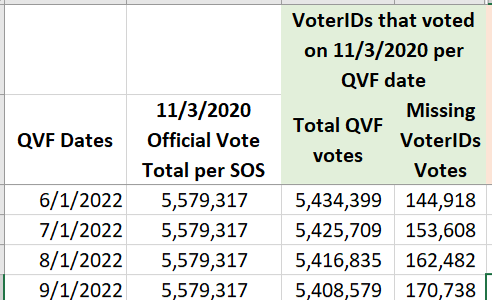
While these observations should be significant enough on their own to justify a true, forensic audit of the state qualified voter file, they are not alone. As it turns out, there are quite a few “anomalies” that would justify such an investigation. Let’s take a closer look at the integrity of the state voter registration database in Michigan which is also called the Qualified Voter File (QVF).
Missing Voter IDs
Each voter in the QVF is supposed to be assigned a unique Voter ID at the time their voter record is created. Examination of the QVF, however, reveals that significant numbers of voters were missing their Voter IDs in their voter record.

Why were the Voter ID’s missing? The question remains unanswered.
Votes Added and Removed MONTHS After Election
Another bizarre anomaly that points to someone “tinkering” with election records pertains to odd additions and deletions of voting histories for a given voter.

Election Integrity Force issued a series of reports highlighting the corrupted voter history in the QVF.
Report 1: A Sample Canvass – The Michigan Legislature
Report 2: The Governor of Michigan’s Voting History Corrupted??
Report 3: Irreconcilable Differences
There has never been a satisfactory explanation provided to investigators for these anomalies.
Vote Method Switching
Another unexplained anomaly in the QVF discovered by analysts at the Election Integrity Force pertains to flipping of voting methods from “in-person” to “absentee”.

The above snapshot is but a small sample of voter history records being flipped between in-person and absentee. There is no logical reason for such aberrations.
Data Inconsistencies
On December 16, 2021, I submitted the following FOIA request to the Michigan Department of State (MDOS):
In a spreadsheet compatible electronic format (csv or Excel), provide a list of all 5,539,302 voters said to have voted in Michigan during the 2020 general election.
For each voter identified, include the following information:
Full name (First, Middle, Last)
Full address in compliance with United States Postal Service addressing standards (Street Address, Municipality, State, Zip code)
Date of birth (Year as a minimum)
Voting precinct
County of residence
Method of voting (At polling place or Absentee)
If the method of voting is Absentee, include the following additional information:Permanent absentee voter status (Yes or No)
FOIA Request Submitted on 12/16/2021 (NOTE: 5,539,302 presidential vote count reference later updated to reflect 5,579,317 total ballots cast)
Means by which absentee ballot application was submitted (electronically, mail, in-person, other (specify how))
Organization who received ballot application (e.g. MI Secretary of State, Clerk’s office)
Address where ballot application was received
Date of receipt of Absentee ballot application
Address application was sent to
Address application was received by (if different then address application was sent to)
Date when absentee ballot for 2020 general election was sent to voter
Date when absentee ballot for 2020 general election was received
Address where absentee ballot for 2020 general election was received
List may be broken down into multiple electronic files featuring one million records or less each but should not exceed 1 unique file per county (maximum number of files would be 83). The total number of voter records, however, should be a minimum of 5,539,302.
The response provided by the MDOS further exacerbated concerns with the integrity of the QVF. They provided me with the list of voters who voted in the 2020 General Election. According to that list, only 5,557,171 people voted (2,261,882 in-person and 3,295,289 absentee) which stands in contrast to the official record of 5,579,317 ballots cast. The inconsistency doesn’t stop there, however. Remember, I asked for additional information when a voter cast their vote by mail. This resulted in them providing a separate list of information for absentee voters. In this supplemental list, there were 3,203,915 absentee voters not 3,295,289 as denoted in the first list. Why would the number of absentee voters differ between the two lists? In summary, in addition to inconsistencies between the official votes cast and the list of voters provided, there was also inconsistency between both sets of data provided in the same FOIA response.
Canvassing Results
One of the best ways to investigate the integrity of the information stored in the QVF is to conduct door-to-door canvassing. Canvassing simply seeks to verify the following basic information:
- Is the listed address a valid address?
- Does the voter live at the listed address?
- Did the voter vote in the election?
- If so, did they vote absentee or in-person?
In Macomb County, former staffer in the Chesterfield Township clerk’s office, Jacky Eubanks, conducted a canvass in the wake of the 2020 election. The results of this canvass were quite startling. It indicated a 17.6% fraud rate.
Under the leadership of Joanne Bakale, the Election Integrity Force coordinated canvassing efforts across 8 out of 83 counties in the State of Michigan.
The results indicated an anomaly rate greater than the reported Presidential vote margin of 2.78%. Once again, significant enough to prompt an audit, but no audit was conducted by elected officials.
Address Swaps
An alert United States Postal Service worker in Florida reportedly triggered the discovery of another bizarre voter file anomaly. The postal worker noted 50 voters registered to vote at non-existing addresses on a non-existent street.
Upon further investigation by citizen investigators such as Kristofer Jurski, it appears that their real street name “Cherry Lane” was swapped out temporarily with “Red Belly Road”. Once ballots were mailed out to the phony address, the voter records were updated a week later with the actual address indicating that the real voters had voted yet they had never received their ballots. Someone did, just not the actual voters.
On a side note, most requests for voter registration file updates by election investigator groups are performed on a monthly interval (due to FOIA cost). Changes that revert back to previous state of records within a week would likely not be detected under these circumstances.
Without the initial postal worker observation, this sort of voter registration anomaly would be virtually impossible to detect without access to the QVF transaction log or a post-election via door-to-door canvassing effort.
Where else might this be happening across America?
Dead Voters
On November 4, 2021, the Public Interest Legal Foundation (PILF) filed a federal lawsuit against the Michigan Secretary of State for failure to remove over 25,975 dead voters from the state QVF.
In my book The 2020 Coup I cite evidence of 170 year old Jason LeMoyne Daniel from Flint, MI casting his vote in the 2020 election.

State election records showed that he voted by mail during the 2020 General Election. Talk about dedication to voting!
Local Clerk Data Overwritten
Citizen investigator Scott Aughney teamed with data analyst Tim Vetter to identify some additional data anomalies. They discovered evidence that voter record updates uploaded by local clerks to the state QVF are being changed at the state level after being uploaded.
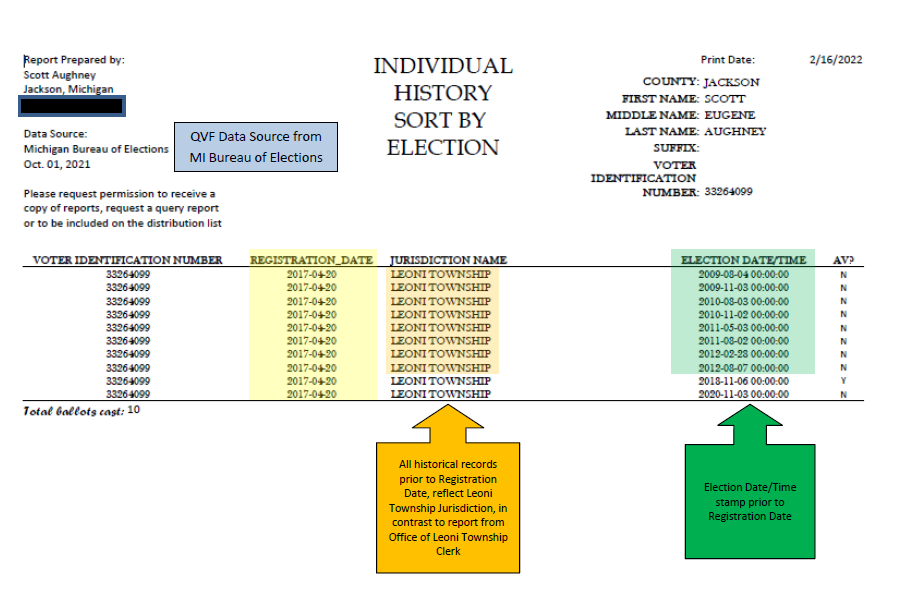
Among the changes noticed are the place where the voter is said to have voted. The records provided by local clerks should be overwriting the data provided by the state and their agents not the other way around.
Algorithmic Precision
Dr. Douglas Frank reviewed the voter turnout information against 2010 census demographics. His analysis led to the observation that he could predict the 2020 voter turnout by demographic simply by knowing the 2010 census demographic distribution. It was clear from his analysis that the assignment of voters to ballots was performed with algorithmic precision.
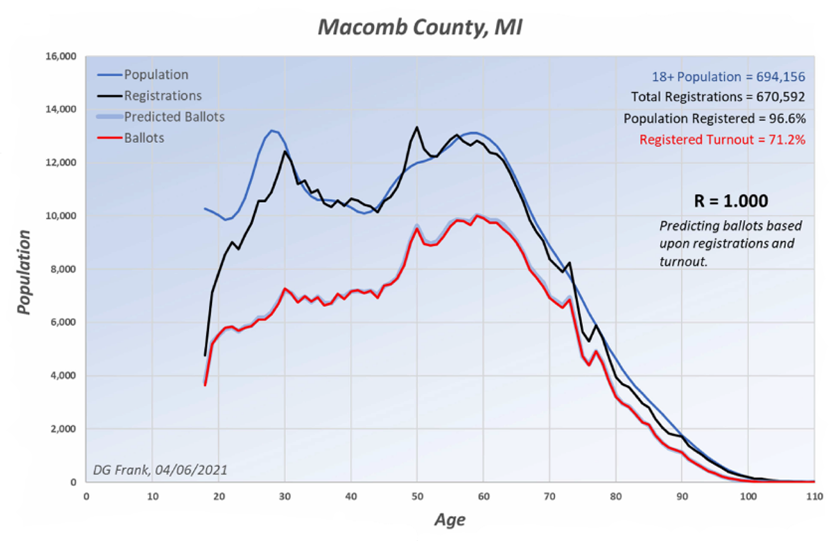
In the words of Dr. Frank “that ain’t natural buddy”. It leads one to conclude that electronic voter management systems (e.g. QVF) were leveraged to issue ballots to voters in accordance with a computer algorithm based upon 2010 census data.
Who Has Access to MI Qualified Voter File?
The vast number of these “anomalies” begs the question, “who has access to the Michigan Qualified Voter File?”
The answer may surprise you. Of course, the Michigan Secretary of State and the Michigan Bureau of Elections under her direction have access. Local clerks also have access so that they are able to upload voter information and receive downloads for electronic poll books in preparation for elections. Who else has access, though?
One of the organizations with which the State of Michigan has entered into data sharing agreements is the Election Resource Information Center (ERIC). The Michigan Bureau of Elections Director, Jonathan Brater, is the current Chair of the ERIC Board. ERIC is a multi-state consortium ostensibly formed to assist states in the cleaning of their voter rolls. A simple review of the aforementioned anomalies indicates that they are not very effective in that capacity. In fact, their emphasis appears to be upon the inflation of voter rolls not the integrity of the voter rolls. In practice, ERIC has served as a partisan Get Out The Vote (GOTV) platform for progressives. Their lack of emphasis upon voter roll integrity and interactions with biased non-government organizations is driving a recent exodus of three states (MO, FL, WV) from the consortium in the wake of earlier departures by Alabama and Louisiana. ERIC was recently caught sharing sensitive voter information with the progressive, Zuckerberg-funded Center for Election Innovation and Research (CEIR).
In addition to ERIC, the state of Michigan has also entered into data sharing agreements with non-government organizations such as Rock the Vote.
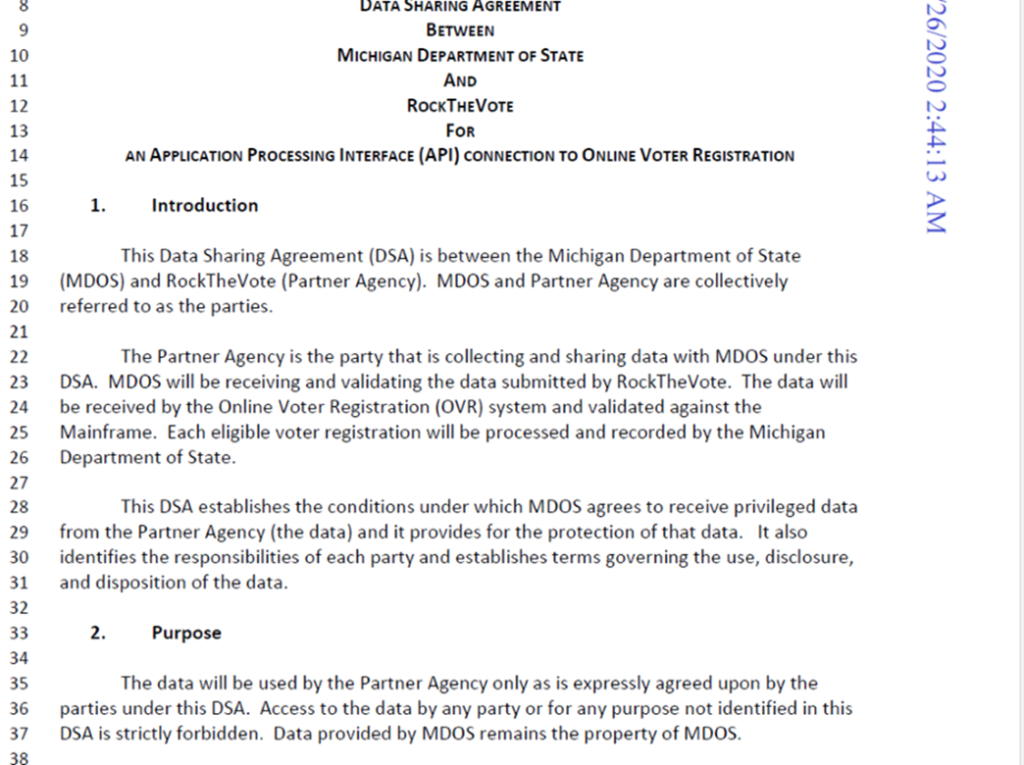
In fact, Rock the Vote has built an Application Program Interface (API) that provides a direct link into the state QVF.

This link provides them with full access to the QVF including sensitive information such as drivers license numbers and dates of birth. The security of this link is suspect in light of the fact that Rock the Vote advertises their API specifications to the general public. That means that the QVF could potentially be modified by virtually anyone with an internet connection.
Many non-government organizations in addition to those already cited have access to the state voter registration file including electronic voting system vendors such as Dominion, Hart, and ES&S.

Everyone seems to have access to the QVF except for citizens seeking to investigate the integrity of the QVF. Why can’t everyday citizens see who is eligible to vote? Shouldn’t everyone have this access?
The Cover-Up
One would think that the findings above would be frontpage news. After all, our election systems have been designated as critical infrastructure for our nation. Any failure in our election system should be treated with the same urgency as a failure in any other critical infrastructure components such as our energy supply, water and wastewater systems, or nuclear reactors. Quite the opposite occurred, however.
Opposing Demands to Clean-up Voter Rolls
How did the Michigan Secretary of State Jocelyn Benson respond to the PILF lawsuit demanding that 25,975 dead voters be removed from the state QVF? She opposed the PILF lawsuit.
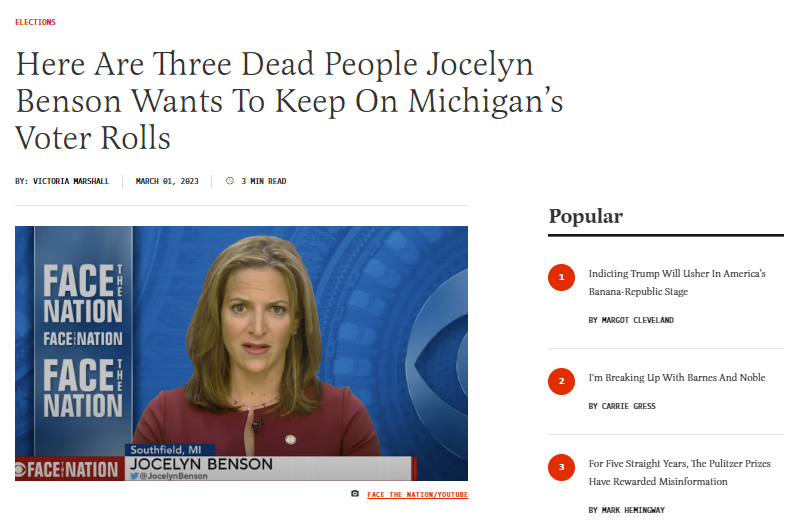
Her opposition to the PILF lawsuits stands in stark contrast with her response to a Priorities USA lawsuit filed by Clinton lawyer Marc Elias. She responded by relaxing signature verification requirements for absentee ballot applications.
One thing that is consistent with Jocelyn Benson is that she is consistently in favor of actions that weaken the integrity of our election system.
FOIA Obstruction
While progressive organizations such as Rock the Vote, CEIR, and ERIC have no trouble accessing the state voter registration database in real time, all others must obtain this information via Freedom of Information Act (FOIA) Requests. More often than not these FOIA requests are met with obstruction. For example, my December 16, 2021 FOIA request for a list of those who voted in the 2020 General Election was not not closed until September 4, 2022. Mind you, the QVF is required by statute to be updated within 30 days of the election. Theses records should have been a simple export from the QVF yet it took almost 10 months to provide the requested data.
Obstruction takes on other forms besides inexplicable delays. The increased reliance of government upon non-government organizations such as ERIC and Rock the Vote means that an increasing segment of our election management operations are not even subject to FOIA requests.
Auditor General Report
On March 4, 2022, the Michigan Auditor General release a report on the Michigan Bureau of Elections management of the QVF.
There were four objectives specified in the report:
- To assess the sufficiency of BOE’s efforts to maintain the integrity of the QVF
- To assess the effectiveness of selected application access controls over QVF and the Electronic Poll Book
- To assess the sufficiency of selected BOE post-election audit procedures to help ensure the integrity of elections.
- To assess the sufficiency of BOE’s efforts to establish and provide training to the county, city, and township officials who are responsible for conducting elections
According to the Michigan Auditor General, none of the anomalies cited above justified any concern with the integrity of the QVF under the oversight of MI Secretary of State Jocelyn Benson. In fact, their assessment of the Michigan Bureau of Elections operations deemed that they were “Sufficient, with exceptions” or “effective”. All “exceptions” cited were minor findings not directly related to the integrity of the QVF such as insufficient training. My independent analysis of their report came to a much different conclusion. The Auditor General did not even start their analysis with the official number of ballots cast according to the Michigan Secretary of State. Why would the Auditor General produce such shoddy work? Why were they not held accountable for such negligence during subsequent committee hearings by elected officials responsible for election oversight?
The Solution
What is the solution to these QVF “anomalies”? In a word…transparency.
Nothing in law prohibits election officials from posting non-sensitive voter information that could be used to verify voter roll integrity such as name, address and age free of charge to the public. All of this information is already available to citizens willing to spend thousands of dollars on FOIA requests to obtain snapshots of the QVF. In light of the importance of this information to the integrity of our elections, every clerk interested in election integrity should post this information for their jurisdiction in a downloadable format on their municipal websites. Citizens can then canvass their neighborhood to verify the integrity of their local voter rolls.
While we patiently wait for election officials to let everyday citizens help them clean our voter rolls, there are organizations and individuals seeking to make this information available right now. The PILF has launched a national tool they refer to as the Interactive Voter Roll Error database. Tech savvy citizens in Michigan have launched the website CheckMyVote.org to enable citizens to check on the integrity of Michigan’s voter rolls.
As important as publishing our voter rolls online for all to see is, even more important is the need to publish a substantive transaction log that tracks changes to our voter rolls. These transaction logs need to specify the following information as a minimum:
- Who specifically (no generic user accounts allowed) changed the voter record?
- When was the voter record changed?
- What part of the voter record was changed?
- Why was the voter record changed?
Perhaps more ambitious than improving the transparency of our voter rolls and voter roll database transactions is the need to eliminate exclusive Third Party Access to voter rolls. Our voter rolls should be open to everyone or no one.
Conclusion
Due to a lack of transaction logs, we do not know exactly who is corrupting our state voter registration files. All that we know for sure is that they have been corrupted.
Local clerks clean up our voter rolls only to discover when they download the latest voter rolls for electronic poll books prior to the next election that their changes have been overwritten by the state and/or parties acting on behalf of the state. Clearly, this is unacceptable. Clerks interested in the integrity of our elections can make significant strides to improve transparency without another law being passed simply by implementing the solution outlined above. Organizations such as CheckMyVote.org or PILF can help make this happen.
In the final analysis, the only way to restore confidence in the integrity of our elections in America is with improved transparency.
RELATED STORIES
- BOMBSHELL! Emails Show Soros-Funded ERIC Was SHARING Voter Information With Third-Party Group Tied to Zuckerberg in 2020 Election.
- Let’s Audit the MI Auditor General Report on Elections
- How Exactly Does Mail-In Ballot Cheating Occur?
- Two Keys to Securing Our Elections
- Statewide Voter Registration File Audits: Very Insightful
- Michigan Mail-In Voting Issues


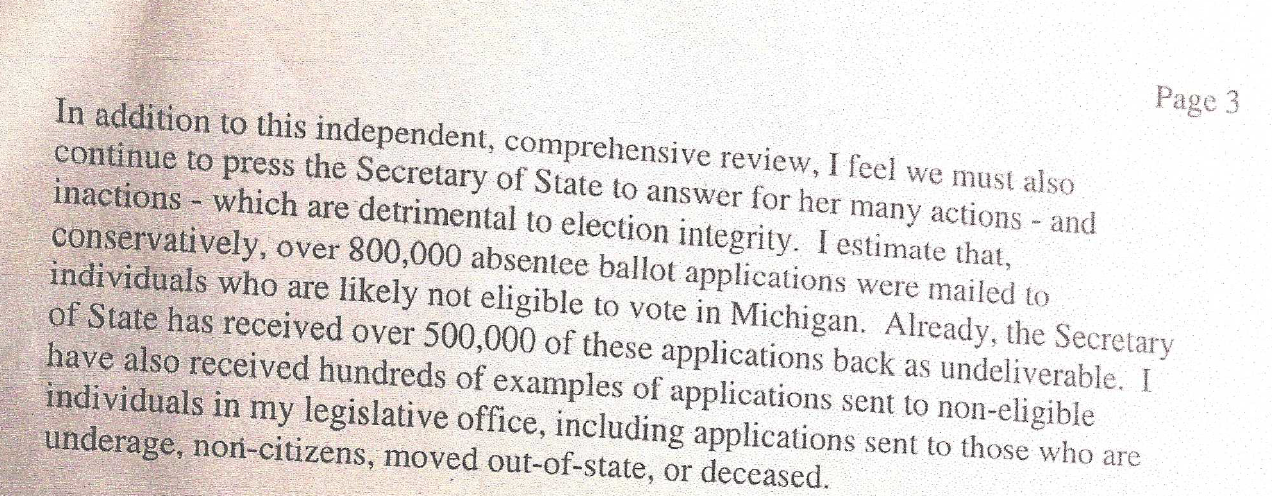
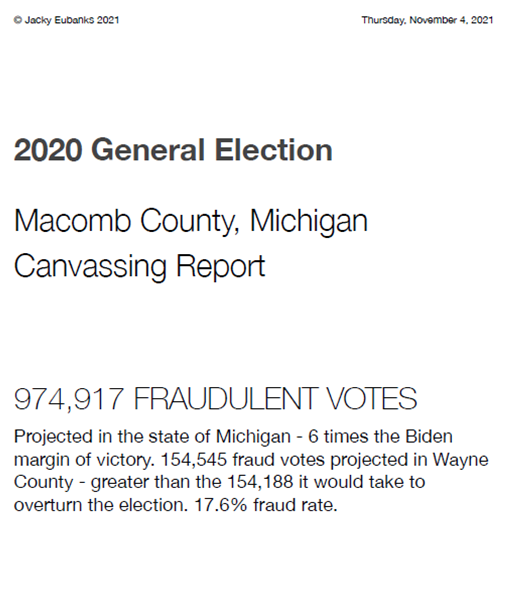
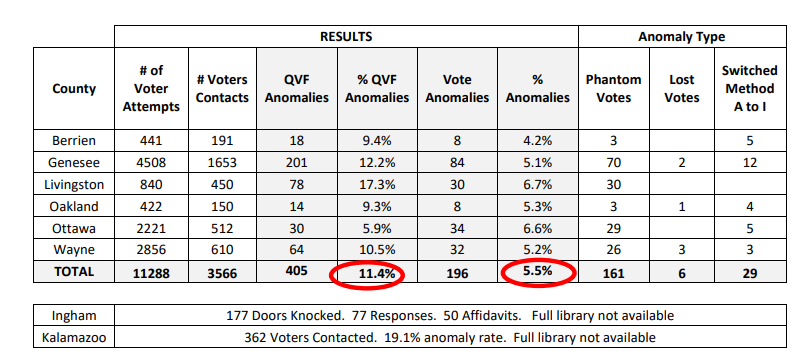
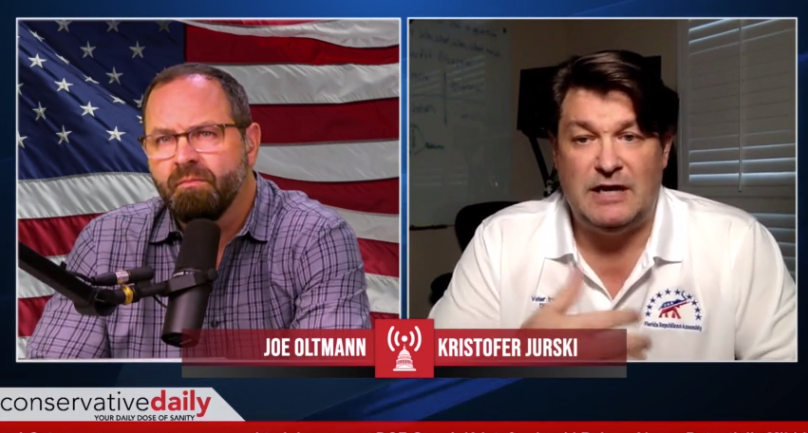
Nothing will ever improve until someone goes to jail. Problem is, nothing ever happens to the people who commit these ‘non-violent’ crimes even though they cause massive trouble for people and society.
Looks like you clueless when it comes to election integrity. Have you volunteered in Detriot or other Democratic regions. I highly doubt that. Patrick, myself, & MANY others have. We EXPERIENCED cheating that was done in front of everyone. They lie and cheat. I saw myself. You need to get involved or be quiet. U don’t even know what your talking abt. One of my friends saw out of state license plates from Ca. Nevada etc.. They had large bags FILLED with ballots. Yet, ur only allowed 1 vote. Watch the documentary 2000 Mules, you just might wake up. You should apologize to Pat.
What would you do to me if you were in my vila? http://prephe.ro/Bdsn
Anybody looking for a smoke buddy? http://prephe.ro/Bdsn
Wow, Patrick, thanks for the conspiracy theory! It’s amazing how you completely ignore the fact that centralized voter registration databases have actually helped to reduce voter fraud and increase the accuracy of voter rolls. Your fear-mongering about mail-in voting is also completely unfounded and ignores the fact that it has been used safely and effectively for years. Maybe try sticking to facts instead of baseless claims.
Looks like you clueless when it comes to election integrity. Have you volunteered in Detriot or other Democratic regions. I highly doubt that. Patrick, myself, & MANY others have. We EXPERIENCED cheating that was done in front of everyone. They lie and cheat. I saw myself. You need to get involved or be quiet. U don’t even know what your talking abt. One of my friends saw out of state license plates from Ca. Nevada etc.. They had large bags FILLED with ballots. Yet, ur only allowed 1 vote. Watch the documentary 2000 Mules, you just might wake up. You should apologize to Pat.
Keep at it, Patrick! This is a worthwhile cause. Not many are in it for the long haul, but you’ve made such progress. Thanks for the updates for us Michiganders. Many stand with you! I bought your book and I’ll buy the next one.
Anybody looking for a smoke buddy? http://prephe.ro/Bdsn
For the reason that the admin of this site is working, no uncertainty very quickly it will be renowned, due to its quality contents.
A red lip makes me feel sexy 🙂 http://prephe.ro/Bdsn